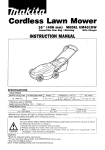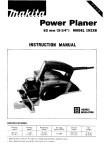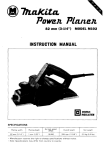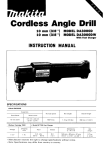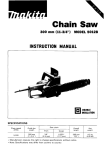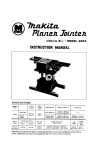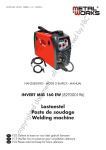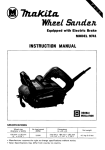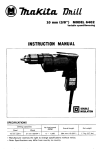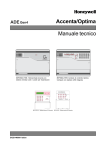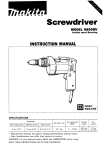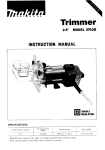Download Makita 1100 Planer User Manual
Transcript
Power Planer
82 mm ( 3 4 4 ” )
MODEL 1100
INSTRUCTION MANUAL
DOUBLE
INSULATION
SPECIFICATIONS
Planing
width
Planing
depth
Rabbeting
depth
No load speed
(RPM)
Overall
length
Net
weight
82 mm
(3-114”)
3 mm
(118“)
20 mm
16,000
415 mm
(16-318”)
4.9 kg
(10.8 Ibs)
(314”)
Manufacturer reserves t h e right to change specifications w i t h o u t notice.
* Note: Specifications may differ from country t o country.
IMPORTANT
SAFETY INSTRUCTIONS
(For All Tools)
WARNING: WHEN USING ELECTRIC TOOLS, BASIC SAFETY PRECAUTIONS SHOULD ALWAYS BE FOLLOWED TO
REDUCE THE RISK OF FIRE, ELECTRIC SHOCK, AND PERSONAL INJURY, INCLUDING THE FOLLOWING:
READ ALL INSTRUCTIONS.
1. KEEP WORK AREA CLEAN. Cluttered areas and benches invite injuries.
2. CONSIDER WORK AREA ENVIRONMENT. Don't use power tools in damp
or wet locations. Keep work area well lit. Don't expose power tools t o rain.
Don't use tool in presence of flammable liquids or gases.
3. KEEP CHILDREN AWAY. All visitors should be kept away from work area.
Don't let visitors contact tool or extension cord.
4.STORE IDLE TOOLS. When not in use, tools should be stored in dry, and high
or locked-up place - out of reach of children.
5. DON'T FORCE TOOL. It will do the job better and safer at the rate for which
it was intended.
6. USE RIGHT TOOL. Don't force small tool or attachment t o do the job of a
heavy-duty tool. Don't use tool for purpose not intended.
7 . DRESS PROPERLY. Don't wear loose clothing or jewelry. They can be caught
in moving parts. Rubber gloves and non-skid footwear are recommended
when working outdoors. Wear protective hair covering t o contain long hair.
8. USE SAFETY GLASSES. Also use face or dust mask if cutting operation is
dusty.
9. DON'T ABUSE CORD. Never carry tool by cord or yank it t o disconnect from
receptacle. Keep cord from heat, oil, and sharp edges.
10. SECURE WORK. Use clamps or a vise t o hold work. It's safer than using
your hand and it frees both hands t o operate tool.
11. DON'T OVERREACH. Keep proper footing and balance at all times.
12. MAINTAIN TOOLS WITH CARE. Keep tools sharp and clean for better and
safer performance. Follow instructions for lubricating and changing accessories. Inspect tool cords periodically and if damaged, have repaired by authorized service facility. Inspect extension cords periodically and replace if
damaged. Keep handles dry, clean, and free from oil and grease.
13. DISCONNECT TOOLS. When not in use, before servicing, and when changing accessories, such as blades, bits, cutters.
2
14. REMOVE ADJUSTING KEYS AND WRENCHES. Form habit of checking to
see that keys and adjusting wrenches are removed from tool before turning
it on.
15. AVOID UNINTENTIONAL STARTING. Don't carry plugged-in tool with finger
on switch. Be sure switch is OFF when plugging in.
16. OUTDOOR USE EXTENSION CORDS. When tool is used outdoors, use only
extension cords intended for use outdoors and so marked.
17. STAY ALERT. Watch what you are doing, use common sense. Don't operate
tool when you are tired.
18. CHECK DAMAGED PARTS. Before further use of the tool, a guard or other
part that is damaged should be carefully checked t o determine that it will
operate properly and perform its intended function. Check for alignment of
moving parts, binding of moving parts, breakage of parts, mounting, and any
other conditions that may affect its operation. A guard or other part that
is damaged should be properly repaired or replaced by an authorized service
center unless otherwise indicated elsewhere in this instruction manual. Have
defective switches replaced by authorized service center. Don't use tool if
switch does not turn it on and off.
19. GUARD AGAINST ELECTRIC SHOCK. Prevent body contact with grounded
surfaces. For example; pipes, radiators, ranges, refrigerator enclosures.
20. REPLACEMENT PARTS. When servicing, use only identical replacement parts.
VOLTAGE WARNING: Before connecting the tool to a power source (receptacle,
outlet, etc.) be sure the voltage supplied is the same as that specified on the
nameplate of the tool. A power source with voltage greater than that specified
for the tool can result in SERIOUS INJURY t o the user - as well as damage to
the tool. If in doubt, DO NOT PLUG IN THE TOOL. Using a power source with
voltage less than the nameplate rating is harmful to the motor.
3
ADDITIONAL SAFETY RULES
1. Rags, cloth, cord, string and the like should never be left around the work
area.
2. Avoid cutting nails. Inspect for and remove all nails from the workpiece before
operation.
3. Handle the blades very carefully.
4.Be sure the blade installation bolts are securely tightened before operation.
5. Hold the tool firmly with both hands.
6. Keep hands away from rotating parts.
7. Before using the tool on an actual workpiece, let it run for a while. Watch
for vibration or wobbling that could indicate poor installation or a poorly
balanced blade.
8. Make sure the blade is not contacting the workpiece before the switch is
turned on.
9. Wait until the blade attains full speed before cutting.
IO. Keep at least 200 mm (8”) away from the tool at all times.
11. Always switch off and wait for the blades t o come t o a complete stop before
any adjusting.
12. Never stick your finger into the chip chute. Chute may jam when cutting
damp wood. Clean out chips with a stick.
13. Do not leave the tool running. Operate the tool only when hand-held.
14.When leaving the planer, switch off and set it with the front base up on a
wooden block, so that the blades do not contact anything.
15. Always change both blades or covers on the drum, otherwise the resulting
imbalance will cause vibration and shorten tool life.
SAVE THESE INSTRUCTIONS.
4
Removing or installing mini planer blades
CAUTION :
Always be sure that the tool i s switched off and unplugged before removing or installing
the blade.
To remove the blades on the drum, unscrew the three installation bolts with the
socket wrench. The drum cover comes off
together with the blades.
1. Remove the existing blade, if the tool has been in use, carefully clean the drum surfaces and the drum cover.
2. Loosely attach the adjust plate t o the set plate with the pan head screws and set the
mini planer blade on the gauge base so that the cutting edge of the blade is perfectly
flush with the inside flank of the gauge plate.
3. Set the adjust platehet plate on the
gauge base so that the planer blade
locating lugs on the set plate rest in the
mini planer blade groove, then press in
the heel of the adjust plate flush with
the back side of the gauge base and
tighten the pan head screws.
4. It i s important that the blade s i t s flush
with the inside flank of the gauge plate,
the planer blade locating lugs s i t in the
blade groove and the heel of the adjust
plate is flush with the back side of the
gauge base. Check this alignment carefully t o ensure uniform cutting.
Inside flank of
\
Mini planer blade
5. Slip the heel of the adjust plate into the groove of the drum.
6. Set the drum cover over the adjust plate/set plate and screw in the three hex flange
head bolts so that a gap exists between the drum and the s e t plate to slide the mini
planer blade into position. The blade will be positioned by the planer blade locating
lugs on the set plate.
5
7. The blade's lengthwise adjustment will
need to be manually positioned so that
the blade ends are clear and equidistant
from the housing on one side and the
metal bracket on the other.
Is
Mini planer blade
Drum
8. Tighten the three hex flange head bolts
(with the socket wrench provided) and
hand rotate the drum t o check clearances between the blade ends and the
tool body.
9. Check the three hex flange head bolts
\
for final tightness.
Groove
IO. Repeat procedures 1-9 for other blade.
Planer blade adjustment
(optional accessory)
To install the blades, first clean out all
chips or foreign matter adhering t o the
drum or blades. Use blades of the same
dimensions and weight, or drum oscillation/vibration will result, causing poor
planing action and, eventually, tool breakdown.
Bolt
Drum
-
Plarier blade
yq
Drum cover
I
Place the blade on the gauge base so that
the t.ade edge is perfectly flush with the
inside edge of the gauge plate. Place the
adjusting plate on the blade, then simply
press in the heel of the adjusting plate flush
with the back side of the gauge base and
tighten two screws on the adjusting plate.
Now slip the heel of the adjusting plate
into the drum groove, then f i t the drum
cover on it. Tighten the three installation
bolts evenly and alternately with the
socket wrench.
'
Adjusting plate
--
Inside edge
of gauge plate
Blade edge
Planer blade
Adjusting plate
Back side of
gauge base
Gauge plate
CAUTION :
Tighten the blade installation bolts carefully when attaching the blades t o the tool. A
loose installation bolt can be dangerous. Always check t o see they are tightened securely.
6
For the correct planer blade setting
Your planing surface will end up rough and uneven, unless the blade i s set properly and
securely. The blade must be mounted so that the cutting edge is absolutely level, that is,
parallel t o the surface of the rear base. Below are some examples of proper and improper
settings .
( A ) F r o n t base (Movable shoe)
(6)Rear base (Stationary shoe)
Although this side view cannot show
it, the edges o f the blades run perfectly
parallel t o t h e rear base surface.
Cause:
Nicks in
surface
One o r b o t h blades fails t o
have edge parallel t o rear base
line.
t o rear base line.
Gouging
at end
~
Adjusting depth of cut
Depth of cut may be adjusted by simply
turning the knob on the front of the tool.
~Cause :
~
One or b o t h blade edges p r o trudes t o o far in relation t o
rear base line.
7
7
Switch action
To start the tool, simply pull the trigger.
Release the trigger t o stop. For continuous
operation, pull the trigger and then push in
the lock button. To stop the tool from the
locked position, pull the trigger fully, then
release it.
Lock button
CAUTION :
Before plugging in the tool, always check t o see that the trigger switch actuates properly
and returns t o the "OFF" position when released.
Planing operation
First, rest the tool front base flat upon
the workpiece surface without the blades
making any contact. Switch on and wait
until the blades attain full speed. Then
move the tool gently forward. Apply pressure on the front of tool a t the start of
planing, and a t the back a t the end of
planing. Planing will be easier if you incline
the workpiece in stationary fashion, so that
you can plane somewhat downhill.
The speed and depth of cut determine the
kind of finish. The power planer keeps cutting a t a speed that will not result in jamming by chips. For rough cutting, the depth of cut can be increased, while for a good
finish you should reduce the depth of cut and advance the tool more slowly.
8
Shiplapping
To make a stepped cut as shown a t the right, use the edge
fence.
Draw a cutting line on the workpiece. Insert the edge fence into the hole in the
front of the tool. Align the blade edge with
the cutting line.
Adjust the edge fence until it comes in contact with the side of the workpiece, then
secure i t by tightening the screw.
You may wish o add to the I ngth of the
fence by attaching an extra piece of wood.
Convenient holes are provided in the fence
for this purpose.
NOTE :
When planing, move the tool with the edge fence flush with the side of the workpiece.
Otherwise uneven planing may result.
Max. shiplapping depth is 20 mm (3/4").
9
Chamfering
To make a cut as shown a t the right, align the "V" groove in
the front base with the edge of the workpiece and plane it
as shown in the figure (A).
Sharpening planer blades
Always keep your blades sharp for the best
performance possible. Use the sharpening
holder to remove nicks and produce a fine
edge.
First, loosen the two wing nuts on the
holder and insert the blades (A) and (B)
so that they contact the sides (C)and (D).
Then tighten the wing nuts.
10
Immerse the dressing stone in water for 2
or 3 minutes before sharpening. Hold the
holder so that the blades both contact the
dressing stone for simultaneous sharpening
a t the same angle.
11
MAINTENANCE
CAUTION :
Always be sure that the tool is switched off and unplugged before attempting t o perform
inspection or maintenance.
Replacing carbon brushes
Remove and check the carbon brushes
regularly. Replace when they wear down
t o the limit mark. Keep the carbon brushes
clean and free t o slip in the holders. Both
carbon brushes should be replaced a t the
same time. Use only Makita carbon brushes.
/
L i m i t mark
Use a screwdriver t o remove the chip cover
as shown in the figure.
Screwdriver
I
Chip cover
Use a screwdriver t o remove the brush
holder caps. Take out the worn carbon
brushes, insert the new ones and secure the
brush holder caps.
I
/
Brush holder cap
1
To maintain product SAFETY and RELIABILITY, repairs, any other maintenance or
adjustment should be performed by Makita Authorized or Factory Service Centers,
always using Makita replacement parts.
12
ACCESSOR I ES
CAUTION :
These accessories or attachments are recommended f o r use w i t h your Makita t o o l specified in this
manual. The use of any other accessories o r attachments m i g h t present a risk of injury t o persons.
The accessories o r attachments should be used o n l y in t h e proper and intended manner.
0 Replacement
baldes
W i d t h : 8 2 mm (3-1/4")
Part No. 7 3 1 0 0 1 - 4
.Mini planer blades
(Material : Tungsten-carbide)
Width : 8 2 mm ( 3 - 1 / 4 ' )
Part No. 793322- 2
(Use w i t h set plate 343433- 9 )
0
Dressing stone
Part No. 7 4 1 8 0 2 - 2
PIaner blades
(Material : Tungsten-carbide)
W i d t h : 82 mm ( 3 - 1 / 4 ' )
Part No. 7 3 1 2 0 1 - 6
0
Bevel guide
Part No. 123032-1
0
Guide rule
Part No. 161046-2
Socket wrench
Part No. 7 8 2 2 0 9 - 3
0 ( + ) Screwdriver
Part No. 7 8 3 0 0 2 - 8
*Sharpening holder
Part No. 123004-6
0 Blade
gauge
Part No. 123010-1
.Hex flange hd. b o l t s
Part No. 2 5 1 9 2 0 - 3
0
Steel carrying case
Part No. 181 1 7 8 - 9
Y
13
May-l5-'90
US
82 mm (3-1/4')
POWER PLANER
Model 1100
Note: The switch, noise suppressor and other part configurations
may differ from country to country.
14
MODEL 1100
ITEM
NO.
NO.
USED
Mav-15-'90
DESCRIPTION
9
11
12
13
14
15
16
17
18
19
20
21
22
23
24
25
26
21
28
29
30
31
2
1
2
2
1
2
1
2
1
1
3
1
1
1
1
1
1
1
1
1
1
1
2
2
2
1
1
2
2
1
1
32
-
DESCRIPTION
MACHlNE
MACHINE
__
1
2
3
4
5
6
7
8
'Yz G2D
US
Pan Head Screw M3x6 (With Washer]
Name Plate
Pan Head Screw M5x18 {With Washer1
Rivet 0 - 5
Switch
Pan Head Screw M4x6 IWlfh Washer1
Cord Guard
Pan Head Screw M4x18 (With Washer)
Strain Relief
Cord
Pan Head Screw M4x28 lWith Washer)
Handle Cover
Ball Bearing 620OLB
Insulation Washer
FIELD ASSEMBLY
ARMATURE ASSEMBLY
IWnh item 14. 15 & 17 - 191
Fan 80
Ball Bearing 620oLLB
Bracksl
V Pulley 5-26 5L
Poly V Be11 5-265
Belt Cover
Pan Head Screw M4x25 (With Wssherl
Brush Holder Cap
Carbon Brush
Motor Housing
Rubber Pin 4
Pan Head Screw M5x65 IWith Washer & Bond1
Pan Head Screw M4x6 iWith Washer)
Baffle Cover
Rubber Pm 4
33
34
35
36
37
38
39
40
41
42
43
44
45
46
41
48
49
50
51
52
53
54
55
56
57
58
59
60
61
62
63
64
5
1
1
1
1
1
1
1
1
1
1
1
1
1
1
1
6
2
4
2
2
1
1
1
1
1
1
1
1
4
1
1
Pan Head Screw M4x25 IWith Washerl
Knob 50
Flat Washer 10
Chip Cover
Pan Head Screw M4x20 IWith Washerl
Spring Pin 4-40
Drum Cover
Wing Bolt M5x10
Spring Washer 5
Flat Washer 5
Depth Guide
Screw M 6 x l 3
Main Frame
Compression Spring 17
Rubber Packing
Front Base
Hex Flange Head Bolt M 6 x l l
Drum Plate
Pen Head Screw M4x5
Adjust Plate
Pan Head Screw M5x18 (With Washerl
Drum Rear Shaft
Flat Washer 8
Ball Bearing 60822
Retaming Ring 5-8
Dl"W
Ball Bearing 620122
Rubber Pin 6
Drum Housing
Pan Head Screw M 4 r 1 4 IWith Washer)
V-Pulley 5-29 4
Slasve 10
Note. The switch and other part specificstions may differ from country to country.
15
f
MAKITA LlMrED ONE YEAR WARRANTY
Warranty Policy
Every Makita tool is thoroughly inspected and tested before leaving the factory. It is warranted to
be free of defects from workmanship and materials for the period of ONE YEAR from the date of
original purchase. Should any trouble develop during this one- year period, return the COMPLETE
tool, freight prepaid, t o one of Makita’s Factory or Authorized Service Centers. If inspection shows
the trouble is caused by defective workmanship or material, Makita will repair (or at our option,
replace) without charge.
This Warranty does not apply where:
repairs have been made or attempted by others:
repairs are required because of normal wear and tear:
The tool has been abused, misused or improperly maintained;
alterations have been made to the tool.
IN NO EVENT SHALL MAKITA BE LIABLE FOR ANY INDIRECT, INCIDENTAL OR CONSEQUENTIAL DAMAGES FROM THE SALE OR USE OF THE PRODUCT. THIS DISCLAIMER
APPLIES BOTH DURING AND AFTER THE TERM OF THIS WARRANTY.
MAKITA DISCLAIMS LIABILITY FOR ANY IMPLIED WARRANTIES, INCLUDING IMPLIED
WARRANTIES O F “MERCHANTABILITY” AND “FITNESS FOR A SPECIFIC PURPOSE,”
AFTER THE ONE-YEAR TERM OF THIS WARRANTY.
This Warranty gives you specific legal rights, and you may also have other rights which vary from
state to state. Some states d o not allow the exclusion or limitation of incidental or consequential
damages, so the above limitation or exclusion may not apply t o you. Some states d o not allow
limitation o n how long an implied warranty lasts, so the above Limitation may not apply to you.
Makita Corporation
3-11-8, Sumiyoshi-cho,
Anjo, Aichi 446 Japan
883001BO63
PRINTED IN JAPAN
1991 - 8 - N
















